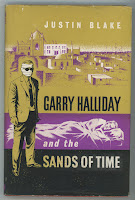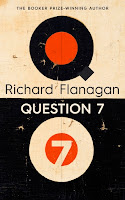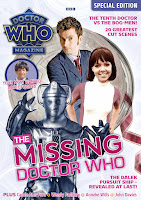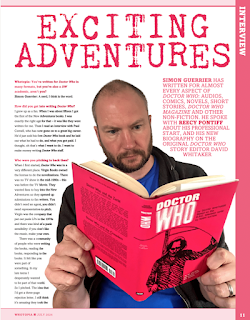At the end of the third Garry Halliday novelisation, airline pilot and adventurer Garry skis down a mountain in Switzerland in time to catch the elusive criminal mastermind known as the Voice. Until now, no one - not even his own henchpeople - have seen his face. The Voice is sent to prison - and then promptly escapes.
In this next adventure, the Voice aims to deal with the 10 people who clapped eyes on him during his short time as captive, and thus regain his anonymity. The Swiss police inspector, the pilot of the plane who flew the Voice from Switzerland back to London and some prison staff at Pentonville each go missing for a week or so, and then are found with their memories wiped. As Garry, his trusty co-pilot Bill Dodds and their friend Inspector Potter from Scotland Yard investigate, they too face capture and the same sinister process.
This fourth Garry Halliday serial - broadcast over seven weeks between 5 November and 17 December 1960, never repeated but published in book form around September 1963 - taps into a contemporary fear. Brainwash Culture, Daniel Pick's 2016 documentary for Radio 3, is very good on the history of this, in real life and popular culture (and very useful when I wrote my book on 1967 Doctor Who story The Evil of the Daleks).
In short, during the Korean War (1950-53), reports emerged of coercive techniques being used by Maoist forces. This "brainwashing" was cited to explain why western prisoners of war had apparently aided their captors and why 21 American soldiers asked not to be repatriated. Whatever the truth behind these claims, they informed Richard Condon's 1959 novel The Manchurian Candidate, in which a loyal American soldier undergoes conditioning that makes him commit treason. An acclaimed film version starring Frank Sinatra was released in 1962, the same year that Anthony Burgess' A Clockwork Orange and Len Deighton's The IPCRESS File were published, both exploring the disturbing ways in which such techniques might be exploited.
We can see similar ideas being explored in such fare as the 1963 film The Mind Benders, the opening of Ian Fleming's 1964 novel, The Man with the Golden Gun (when James Bond is the victim of such techniques!) and lot of early Doctor Who. It's a particularly effective wheeze in TV and film, where we can see the conflict of "good" characters struggling to fight the conditioning.
Garry Halliday was tapping into the zeitgeist and was perhaps even a bit ahead of the game. But it's odd that the characters we see brainwashed are mostly those we don't otherwise know - the Swiss inspector and prison staff. Inspector Potter, who is also subjected to the technique, featured in the previous serial but played by a different actor, which may have lessened the impact of seeing him "turned" to work for the villains. At one point, Garry Halliday succumbs to the drugged water that begins the brainwashing process but we don't see him act out of character. Bill Dodds is also unaffected. It felt to me as though an obvious bit of drama had been missed.
Then there's the sense of the novelisation patching over holes in the storyline, for example why the Voice can only be recognised by the few people who saw him, rather than from a mug shot when he was arrested.
"What records there were of him had disappeared. There was one newspaper photograph. Even the Voice couldn't get rid of every copy of a newspaper with a circulation of four and a half million. The newspaper picture was blurred and grey on bad paper. It showed a bulky man with an arm over his face. Such as it was, it had been circulated to the police of every country in the world. Most of those to whom if had been circulated had replied, more or les politely, that it seemed useless as a means of identification." (p. 19)
The not quite stated implication is that he has people in the police and in newsrooms who have disposed of the original photographs. The irony, of course, is that very little in the way of visual or written records survive related to Garry Halliday.
That makes it difficult to grasp exactly what this serial would have looked and felt like on screen. As on previous serials, the location filming featured in publicity. In the story, the Voice is working from the fictional state of Balakesh, a short distance from real-life Tripoli. Producer Richard West says in his memoir The Reluctant Soldier & Greasepaint and Girls that he, co-writer Jeremy Bullmore, lead actor Terence Longdon, cameraman Tony Good and West's assistant (which may have been Jean Hart) flew out to Tripoli to film picturesque shots on location, without any idea what the story would entail. The plot would be devised around whatever they shot.
In fact, West says, not having prior permission to film outside the American-run Wheelus Air Base, they were all arrested. On another occasion, locals interrupted filming by throwing rocks. The suggestion is that the guerrilla crew didn't get as much footage as they'd have liked and these frustrations may have coloured the way that Balakesh was depicted.
There had been criticism of previous Garry Halliday serials for stereotypical depictions of silly foreigners. The Arabs here are by turns parochial, corrupt and greedy. Bill Dodds at one point adopts a disguise, half naked and blacked up. The novelisation tells us, not very convincingly, that this was,
"not in the hope of being taken for an Arab but simply so as to make it more difficult for anyone to see him" (p. 105).
Halliday expresses horror at the death penalty being used in Balakesh, though capital punishment wasn't abolished in the UK until 1965 (and not until 2000 for all circumstances). But I think the harshness of the regime is all set-up for the end of the story. The Sheikh allows the Voice to escape into the desert, which is effectively a death sentence. The Voice is last seen wandering lost in the sand with nothing to drink.
There's no mention in the surviving sources that actor Elwyn Brook-Jones was part of the crew out in Tripoli, so I wonder how this haunting scene was conveyed on screen. As with the ski chase at the end of the previous serial, it has the potential for arresting visuals if filmed out on location, and for something much less exciting if realised in studio.
On TV, this wasn't the end of the Voice. Yet by the time the book was published, Brook-Jones was dead and Garry Halliday was no longer being made or repeated. The authors therefore tell us in a foreword that this is the last of Halliday's encounters with the Voice and provide some background to the character. They say this is what Halliday subsequently learned - suggesting that this information was not given in the TV version.
Bill Dodds and his fiancee Sonya Delamare, played by Terence Alexander and his wife Juno, had also left the series, their last appearance at the end of the fifth serial. In this, their penultimate adventure, Sonya has relatively little to do, and based on the novelisation it doesn't look as though the couple were involved in location filming. Oddly, whereas the previous three novelisations were narrated by Dodds, here the story is told in the third person, as if preparing the way for his exit. We're told Bill and Sonya are now happily,
"settled down to domestic life and two kids (at the present count)" (p. 11)
But I wonder how happy things really were as the actors left the series.

































